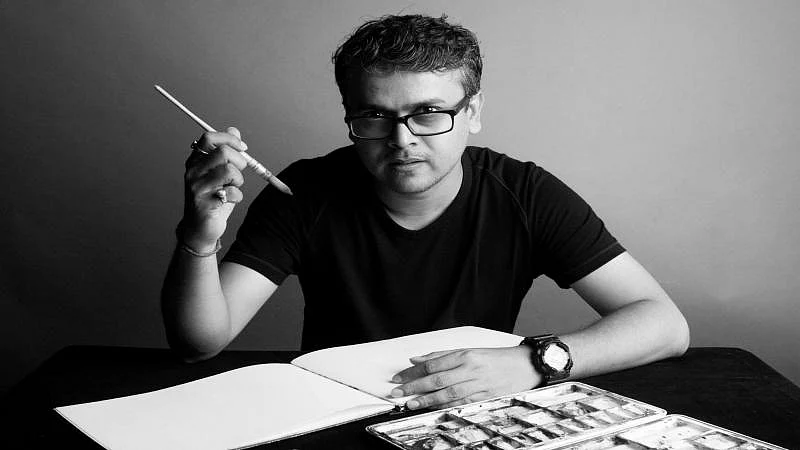Painful to see visual artists not getting royalty, says Rahul Chakraborty
Indian watercolour artist Rahul Chakraborty talks about the absence of artist royalties, and the challenges faced by the art community

Indian watercolour artist Rahul Chakraborty says that the art world is still struggling to survive the impact of lockdowns, travel bans and social distancing, one and a half years into the lockdown. Add to it the absence of artist royalties, and the challenges increase even more for the community in India.
"It brings with it such a scenario that there are no more physical exhibitions, no more physical workshops/classes, and still artists have to continue to earn enough to live. It's painful to see that the creator is not getting any royalty for their art pieces, whereas buyers and sellers earn exponential amounts of value in terms of art and money," Chakraborty tells IANSlife.
Chakraborty, who now works as the COO of art-tech organisation Jumbish, quit his financially stable nine-to-five job to become a full time artist, notwithstanding the financial uncertainties of an artist's life. He has also established his own art school called RahulOnkon. He says his artistic traits were considerably influenced by Fabriano InAcquarello, and has become the Asia -- Continental Admin of the International Watercolor Museum platform.
"For the art domain, the lockdown presents an unprecedented challenge, but it has also brought a huge opportunity to grow as new ways to reach audiences via online can be done by the artist themselves. In the last couple of years multitudes of online galleries, platforms, marketplaces and even social media shops have started distributing and selling artworks through the internet. A great opportunity for artists everywhere to share their art and broaden their audience. But the competition is tough, and it isn't always easy to understand how to make your art visible."
"Upcoming artists need to educate and upgrade themselves about technology and its implications. They need to open up their outlook for the NFT platform. In the coming days, NFT is going to be the gamechanger. Early adopters can have an extra edge in this era. I believe probable art buyers would be the millennials, who are now in their twenties. We need to make our art visible to those platforms/mediums where our would-be buyers are," says the artist.
Speaking about the concept of artist royalties, he explains: "Artist re-sale rights or Droit De Suite, as known in French terminology, is both an example of an economic right as well as an extension of the personhood theory of Copyright Law, which emphasizes upon a work representing the character and personality of the artist/author. It becomes an essential part of moral rights, particularly for visual artists."
"This permits the authors of artistic works to benefit from the rising value of the work, due to the nature of an artwork being one, wherein, value appreciates with time, popularity and its varied interpretation. The art market has been argued to be too volatile to predict when or to what extent a piece of artwork may rise in value, if it does at all, and it needs exposure and multiple sales to get to such a point.. Artists may initially sell their unique, one piece, artwork for a lower cost, however the value may appreciate upon garnering popularity, and it is imperative to not jeopardize their interest in the same."
According to Sonam Chandwani of KS Legal and Associates, information about copyright and royalties is not a widely-discussed topic in the creative world, especially the art market. The lawyer says that artists are eligible to get royalties upon the resale of their works.
"The issue of royalty for visual artists has been long overdue. Like musicians and authors, visual artists deserve to be compensated for their intellectual property and today with blockchain technology, it seems very possible. This will undoubtedly be a positive move for the welfare of the artist community. This is a necessary disruption that requires to happen to bring in more parity for the artist in the secondary art market."
"According to me this is inevitable -- if not in the immediate but definitely in the distant future. The bigger question is how it will shape the market. The general perception is that blockchain enabled royalty system will challenge the intermediaries, like galleries, curators and dealers, because it will force transparency in an industry where much of the market thrives on information asymmetry. This might not necessarily be the case. A greater system generated transparency will bring in more professionalism within all the players in the ecosystem," Lubna Sen, Art Curator, and Founder -- The Art Route, told IANSlife.
How is Jumbish tackling the issue?
"Piracy, no royalty and a long gestation period are very common challenges faced by an artist. We bring a solution to these through our flagship project -- JDAT. This provides better and paperless provenance for our art collectors. Remember royalty and provenance are interrelated. Provenance is a record of ownership of that art work, which includes the owner's history and the painting details."
"To keep track of it, Jumbish has brought a microchip called Jumbish Digital Authentication Tag (JDAT) which is a highly secured chip and it can be read by any NFC reader device. JDAT apparently looks like a thin paper, once it pastes at the back side of the painting then the painting becomes itself an authentication certificate."
With pioneering technology like JDAT, the artist can expect to get paid a predetermined percentage of the resale amount, as soon as the sale is sealed.
Follow us on: Facebook, Twitter, Google News, Instagram
Join our official telegram channel (@nationalherald) and stay updated with the latest headlines